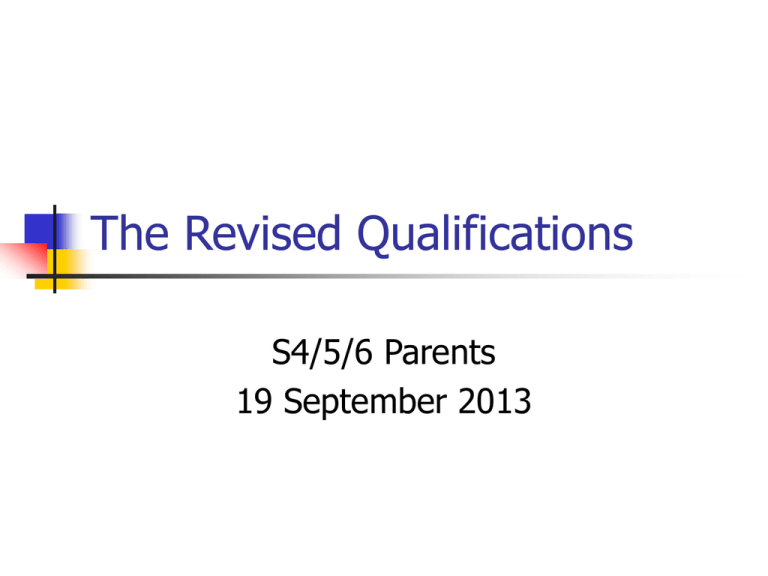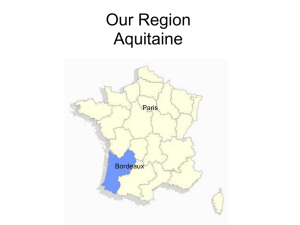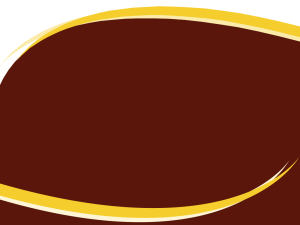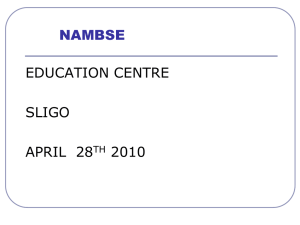HERE - Westhill Academy
advertisement

The Revised Qualifications S4/5/6 Parents 19 September 2013 Qualification Framework Old System Revised System Curriculum for Excellence from May 2014. 1/2 Access 1 and 2 Access 1 and 2 National 1/2 1/2 3 Foundation S Grade Access 3 National 3 3 4 General S Grade Intermediate 1 National 4 4 5 Credit S Grade Intermediate 2 National 5 5 6 Higher Higher Higher 6 7 Advanced Higher Advanced Higher Advanced Higher 7 Assessment in the Revised Qualifications National 1/2/3/4 are entirely internally assessed. 3 units plus a value added task at National 4. They are pass/fail. National 5/Higher/Advanced Higher have mostly 3 internally assessed units and external examination(s). Graded A to D, with A, B and C being passes. Appeals from May 2014 This is the last year of the current system. From May 2014 there will be no “post-result” appeals but there will be “pre-result” appeals. However it is possible to ask for an “administrative check” and/or a remarking of a script. This will have a cost. National Courses In Science… Courses Available National 5 (Physics, Chemistry, Biology). Similar to Credit at Standard Grade and Intermediate 2. National 3/4 (Physics, Chemistry, Biology). Similar to General at Standard Grade and Intermediate 1. These two levels are taught separately. Entry to National Courses For S4 pupils – based on S3 (and S1/S2 performance. For S5/6 pupils – performance in Nat 4/Int 1 /SG /Int 2. Important to get these recommendations right at this stage. What are the courses like? All 3 Sciences at National 4 and National 5 are comprised of three units. At National 5 level, pupils must pass each unit and a final exam for course award. At National 3/4 level, pupils must pass each unit for a course award . How Does Assessment Work? Slightly differently for each level…but the same across the sciences. Assessment for National 5 For each Unit there are three “Assessment Tasks” to complete. Assignment (in school/sent to SQA). Final exam. Assessment for National 4 For each Unit there are three “Assessment Tasks” to complete. Added Value Unit – a fairly lengthy research investigation. Assessment for National 3 For each Unit there are three “Assessment Tasks” to complete. Unit “Assessment Tasks” Common to Nat 3, 4 and 5. Criteria changes slightly for each course. Task 1 An experimental investigation plus report. Pupils must complete all criteria. Teachers can guide pupils. If a pupil passes all criteria, they in one unit, that can also be used as evidence for the other two units. If a pupil fails one or more criteria, they must pass it at a subsequent opportunity. Unit not passed at this stage. Task 1 Task 2 A short report (30-50/40-70/50-100 words). Pupils to select a relevant application from the course and discuss its impact on Society/Environment . Once again, like Task 1…Task 2 need only be passed once, but until its passed, no Unit is complete. Task 2 Task 3 An end-of-unit assessment (previously known as a NAB). KU and PS elements. KU must be passed for each Unit (50%). PS elements must be passed at least once across the 3 units. Summary Selection of course and appropriate level is important. All Assessment Tasks must be completed and so are essential if pupils wish to gain a Unit or Course Award. Nat 4 Nat 3 hopefully straightforward. Nat 5 Nat 4 requires completion of the Added Value Unit. Rewarding Positive Achievement The SQA have agreed….. If a pupil passes the N5 units but fails the examination, by completing the N4 Value Added Unit they will get a N4 course award. This can be planned for, or completed after the examination although this will delay certification. Major Changes and Implications Pupils will only sit one level of examination. This means we have to make decisions with S4 pupils not required in the past. (S4 tracking this week, S4 Parents Meeting November.) The internal assessment of units in all courses means that moderation/standards must be correct. (School, authority, national plans.) No post-result appeals may effect some results. The more efficient use of staffing across the Senior Phase will increase options and decrease class sizes.

![afl_mat[1]](http://s2.studylib.net/store/data/005387843_1-8371eaaba182de7da429cb4369cd28fc-300x300.png)









